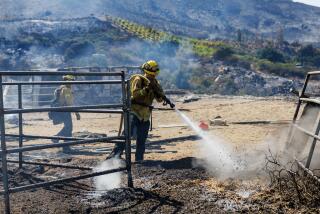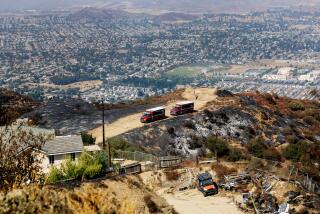Fire officials have defenses up
The expected return of strong Santa Ana winds beginning this afternoon had fire officials across Southern California racing to boost defenses and implement some of the lessons learned during last week’s destructive brush fires.
The National Weather Service on Thursday issued red flag warnings for much of the Southland through at least Sunday night. Though the winds won’t be as fierce as those that sparked October’s blazes, officials said the plummeting humidity levels and record-dry conditions create a high danger for more fires.
Firefighters were paying particular attention to populated canyon and hillside areas that have not burned in recent years, such as Topanga Canyon, Simi Valley, parts of Santa Clarita, the Lake Arrowhead and Big Bear areas and portions of northern San Diego.
Fire departments are placing more “strike teams” in vulnerable areas over the weekend to immediately jump on any fires that might start.
Scores of fresh firefighters are being brought in from across the country to relieve crews that have been on the lines the last two weeks. Federal and state officials also promised to keep more than 30 air tankers and military choppers at the ready -- hoping to avoid the delays that occurred last week in getting air support for firefighters in Orange County and San Diego.
“We’re not letting anybody go that we already got. We have a considerable force thanks to the rest of the country helping us now,” said Kate Kramer, spokeswoman for the the Southern California Operations Center, an interagency decision-making hub. “Nobody’s ready to send everybody home and rest easy on it.”
One thing officials learned last week was that even areas that burned during the 2003 fires had built up enough brush, particularly fast-burning grasses, to burn again.
“Pretty much any area that didn’t burn in these fires can burn,” said Capt. Matt Streck of the California Department of Forestry and Fire Protection. “We found that even areas that burned in the 2003 fires had enough grass grow back to be a danger again.”
The big worry in Orange County is that new winds could whip up the Santiago fire, so officials are using infrared cameras to identify hot spots and hit them with water before the winds pick up.
The Santa Anas arriving today are expected to top off around 45 mph. By contrast, the October winds were clocked at more than 80 mph in some fire zones. But they are plenty strong enough at a time when Southern California is already experiencing its driest stretch on record.
“We always have Santa Anas,” said Bill Patzert, a climatologist for the Jet Propulsion Laboratory in La Cañada Flintridge. “But it’s not normally this dry. The real bad situation is the extreme dryness.”
During the last winter and spring, Southern California experienced 70 Santa Ana days -- more than double the average, Patzert said. The last one happened in May, helping to spawn the Griffith Park fire.
Firefighters said there is little they can do when extremely strong winds -- like those clocked during last week’s fires -- blow through. But they are hoping to be as prepared as possible this weekend.
The U.S. Forest Service was keeping more than 1,000 firefighters over the weekend from Lake Arrowhead to just west of Big Bear Lake, where they have been stamping out the remaining hot spots from the Slide and Grass Valley fires and watching for new blazes.
“We’ll be staffing around the clock, something the Forest Service normally does not do,” said San Bernardino National Forest Fire Chief Mike Dietrich.
That was one of the lessons learned from last week, he said, when the 24-hour shifts allowed firefighters to pounce within five minutes on the Grass Valley fire when it began near Deer Lodge Park.
Fire officials also decided to keep most recreational areas of San Bernardino National Forest closed over the weekend to minimize the risk of human-caused fires in wilderness areas.
The Santa Anas that barreled through the region a week and a half ago were expected, but their duration was not: more than five days.
Streck, the forestry department captain, was injured fighting the Harris blaze in San Diego County when a strong gust pulled his strapped helmet and protective goggles off his head.
“My face was covered with embers,” said Streck, who suffered second-degree burns to one of his eyelids, which remains swollen.
In Los Angeles, Fire Inspector Sam Padilla said strike teams were venturing out to susceptible areas, particularly those that have not burned in a while.
“Topanga Canyon is one area. La Cañada has not burned; neither have the areas east of Glendora, La Verne, areas of Claremont, Pomona, Altadena,” Padilla said. “Those would be areas of concern.”
In San Diego, where the Witch fire destroyed 365 homes, the Fire Department is deploying crews to four additional brush rigs at stations near fire-prone neighborhoods along Interstate 15. Firefighters who will be off-duty on the weekend have been informally told to be ready to deploy if called.
The department’s personnel and equipment will be arrayed much as they were two weeks ago when a Santa Ana was predicted.
“We’re planning for the worst,” department spokesman Maurice Luque said. “Last time, we were right. Let’s hope this time we’re wrong.”
Riverside County was spared from the disastrous fires last week, but extra strike teams from as far as Washington state and Idaho were joining local firefighters to scout the county’s terrain. Two extra water-dropping helicopters, three extra air tankers and a 7,400-gallon air tanker known as the Martin Mars were stationed at Ryan air attack base in Hemet, said Fire Capt. Julie Hutchinson.
“We are dealing with some extraordinary times,” she said. “The potential for fire is everywhere.”
Times staff writer Tony Barboza contributed to this story.
More to Read
Sign up for Essential California
The most important California stories and recommendations in your inbox every morning.
You may occasionally receive promotional content from the Los Angeles Times.










